Modern Fireplace Decorating Ideas
As we cuddle up during the winter months, our fireplaces not only come in handy for keeping us nice and toasty, they also take center stage as one of the focal points of our homes. Now that the holidays are over, take your festive decor down and jump-start your 2020 home decor with these modern fireplace decorating ideas.
1. Alive with Art
A super quick and easy way to style your fireplace is to add a few art pieces on top of the mantle. Grab your favorite pieces, such as a framed painting or even a small sculpture, to brighten up the room and the transformation is done!
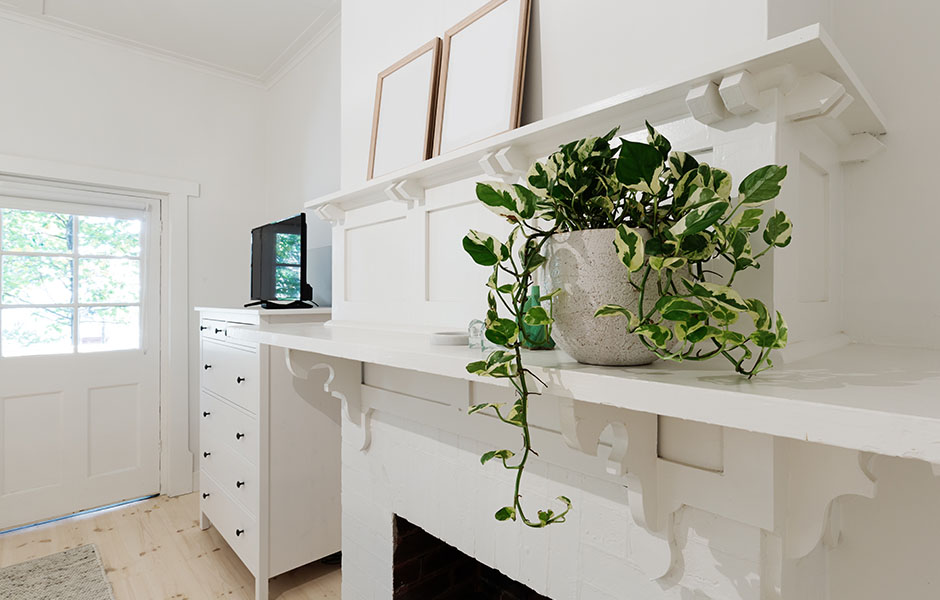
2. Fresh and Green
While plants and a fireplace may not be the most obvious decor pairing, they go together like two peas in a pod. Plant decor is super trendy right now, so framing your fireplace with plants leaves you with a cutting edge look. You can cluster potted plants of different sizes on the floor of the fireplace or on the mantle (the latter might be best if you have pets). If you don’t use the fireplace, consider placing plants inside the hearth as well. Don’t shy away from fake plants if you want low-maintenance decor that gives the same effect. Note: If you choose to decorate with live plants, research their care tips to make sure they will be able to survive in this setting.
3. Black and White
The harsh contrast of black and white is another decor trend we’re seeing this year. You can incorporate this modern fireplace decorating idea quickly and cheaply if that’s what your goal is. For those that have a low budget, you can purchase any white and black decor pieces (art, mirrors, pottery, candles) and create a contrast by placing them above and below the mantle. If you have a higher budget, painting, tiling, and adding wallpaper are more intense options to consider. For example, you can tile your fireplace with black tile and paint the background wall white.

4. Display a Collection
If you like to collect things, put them to use for this modern fireplace decorating idea. Whether it’s pottery or antiques, utilize your mantle to showcase your collection in a place where everyone can enjoy it!
5. Big and Bright
Mirrors are a bold statement piece and 2020’s motto is “go big or go home.” Modernize your fireplace by placing an oversized mirror above the mantle. This is also a great trick for brightening up your room because mirrors reflect natural light.
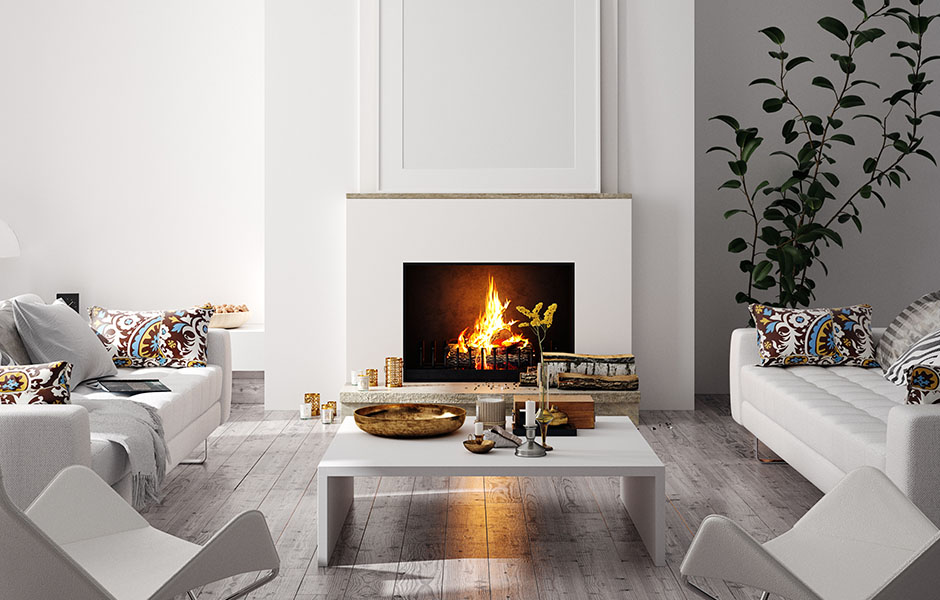
6. Scandinavian Style
Keep your modern fireplace decorating idea simplistic and light by following Scandinavian style. This Nordic interior design trend uses light neutral colors like gray and white, clean lines, and minimalism. Put them all together and your Scandinavian-style fireplace will transform the room into a bright and airy space.
7. Boho Meets Minimalism
Nothing says modern more than minimalism. If this is your kind of style, mix in a little Boho design and apply the magic to your fireplace. Picture a white wall, a couple candlesticks, one pottery piece, and a big modern art painting. So simple and easy!
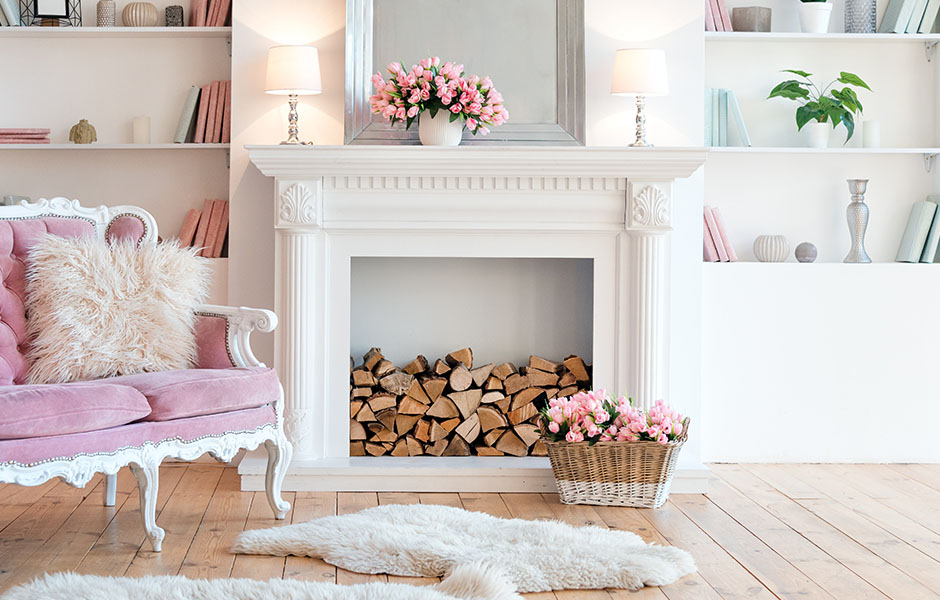
8. Feminine and Fabulous
If contrasting colors and minimalism doesn’t float your boat, you can use this modern fireplace decorating idea to stay trendy. Channel the feminine and fabulous vibe by rocking these three things: gold, color, and fun patterns. For example, decorate with gold-potted plants on your mantle, brightly-colored books along shelving, and patterned tile around the hearth.
9. Higher Heights
For those of you that are looking to completely change the design of your fireplace, this modern fireplace decorating idea is made for you. Floor-to-ceiling fireplaces are totally in and they make for a pretty spectacular focal point. Big, bold, and tall is the name of the game and color is really up to you. The sheer size of a floor-to-ceiling fireplace draws attention, so staying in the neutral color range isn’t going to lessen the impact.
There you have it! Now, pick your style and start off 2020 fresh and modern with these modern fireplace decorating ideas. If you want to make big moves this year and change up your entire living room, check out how to design the perfect living room color palette!
Have you ever walked into someone’s home or looked through pictures in a magazine and thought “wow, all those colors look great together.” Sure, you might know some of your favorite colors or what matches, but developing a color palette is key to cohesive design.
Luckily, developing a living room color palette isn’t as hard as it sounds. By understanding some of the basics about color psychology, color theory, and knowing how to look at a color wheel, you can develop a color palette that’s perfect for your home.
Let’s look at what you need to know when designing the perfect color palette and how to do it.

Basic Color Psychology
Before you get started designing your living room color palette, you should understand the basics of color psychology, or how different colors make you feel. Here are some common feelings associated with certain colors:
– Red – Red is exciting, energizing, aggressive, and passionate
– Orange – Orange is fun, happy, energetic, warm, and enthusiastic
– Yellow – Yellow is cheery, optimistic, fun, and happy
– Green – Green is refreshing, healing, and evokes feelings of generosity, hope, and success
– Blue – Blue is healing, tranquil, peaceful, and calming
– Purple – Purple is mysterious, enlightening, and luxurious
You can use these color emotions to decide how to decorate each room. For example, if you want your living room color palette to be calming and inviting, choose blue hues. If you want it to feel bright and cheery, oranges and yellows will do the trick.
Understanding Color Theory
Color theory is at the core of all interior design trends and you don’t need to be a professional to understand the basics. Let’s break it down:
– The color wheel consists of primary colors, secondary colors, and tertiary colors.
– The primary colors are red, yellow, and blue.
– The secondary colors are colors created when primary colors are mixed, including green (yellow and blue), orange (red and yellow), and purple (blue and red).
– The tertiary colors are colors made from primary and secondary colors, such as red-violet or blue-green. There are six on the color wheel.
– The color wheel is divided into warm colors (reds, oranges, and yellows) and cool colors (blues, greens, and purples)
Using the colors on the color wheel, you can make different hues, shades, tints, and tones.
– Hues are pure colors
– Shades are colors plus black
– Tints are colors plus white
– Tones are colors plus grey
Choosing a Color Scheme for Your Living Room Color Palette
Once you understand the color wheel and how it’s organized, you can start to understand the different color schemes available. Some of the most common color schemes are:
– Monochromatic – Variations in lightness and saturation of a single color
– Analogous – Using colors that are next to each other on the color wheel. One color will dominate, one color will support, and one color will accent
– Complementary – Using colors that are opposite of each other on the color wheel
– Triadic – Using three colors that are evenly spaced around the color wheel so that if you were to draw a line between the colors, it would make a triangle
– Square – Using four colors that are evenly spaced on the color wheel so that if you were to draw a line between the colors, it would make a square
Once you know which colors you want to use, complete your living room color palette with neutrals (black, white, grey, brown, tan, off-white, etc) to finish the look. Browns, tans, and off-whites make a color scheme warmer and blacks, whites, and grays can either be warm or cool, depending on the colors they’re paired with.
How to Create a Living Room Color Palette
So what does all this talk about color wheels have to do with your home? Once you understand the basics of color theory, you can make your own living room color palette to create a cohesive, beautiful style.
Here are the steps to get you started:
- Choose a base color, such as blue.
- Combine shades, tones, and tints to create either a monochromatic, analogous, complementary, triadic, or square color theme. For example, if you like the look of analogous color schemes, you’ll combine colors next to blue on the color wheel, such as greens or purples.
- Choose a complementary hue as an accent color. For example, if your base color is blue, the complementary color is orange.
- Add neutrals to either warm up or cool down your living room color palette. If your color scheme is analogous blues, brown, tan, or off-white will make it more warm and white, black, and grey will make it cooler.
Once you have your living room color palette, you can shop for interior design styles that match. You could choose a neutral tan or brown sofa, add some framed artwork that has your favorite shades and tints of blue, and experiment with subtle pops of orange to tie everything together.
Tools to Help You Create a Living Room Color Palette
Understanding the color wheel and color theory takes time and practice and these are just a few tips to get you started. If you’d like to learn more about color palettes and create your own living room color palette, check out these sites:
– Paletton
– Coolors
If you’re looking for more interior design inspo, check out these bloggers, too! With a little bit of guidance, practice, and basic color theory understanding, you can make your living room look like something straight out of a magazine.
Finding the perfect gift for everyone on your list is a lot of work. From hitting all of the holiday sales to crossing gifts off your list, Christmas shopping can get tiring. But, sometimes the best gift isn’t one that you’d find at the mall. Making your own gift is creative, caring, and can save you some money.
Here is a list of our favorite Christmas craft ideas for gifts!

Christmas Craft Ideas for the Home
Everyone loves receiving things for their homes and Christmas is the perfect time to make something special for your loved ones. Here are some fun and easy Christmas craft ideas for gifts for your friends and family members that love making their house a home:

Wreaths
You can’t have a holiday craft list without wreaths! Wreaths come in all shapes and sizes and make the perfect gift. For this wreath, all you need is a Weeping Willow wreath form made out of branches, some ornaments, some special accents, a hot glue gun, and a ribbon to hang your creation. Or, go all out with a wreath made out of real boughs and greenery. Here’s a list of 80 options!
Embroidery Hoop Ornaments
Some of the best Christmas craft ideas are decorations for the tree! And you don’t even have to be a crafting expert to create some super cute embroidery hoop ornaments. Instead of using traditional embroidery techniques, these ornaments are made by choosing a holiday-themed fabric, such as red plaid, and ironing on a festive vinyl sticker. You can get these stickers for as little as 99 cents, making this an affordable holiday decorating idea.

Filled Glass Ornaments
Glass ornaments are beautiful on their own, but they’re even prettier when they’re turned into a Christmas craft idea for a gift. You can fill these clear ornaments with anything from plants and paint, to mini jingle bells, ribbon, and spa products. Here’s a fun list of things to fill a clear glass ornament with. You can even base them off of your friend or family member’s interior design style! Make multiple and combine them in a gift set for the perfect crafty Christmas.
Napkin Bells
This craft is so simple but will elevate your loved ones’ Christmas table settings. Simply choose a set of beautiful linen napkins and sew miniature jingle bells on the corners. Or, you can make a festive jingle bell napkin ring using mini jingle bells and wire.

Other Christmas Craft Ideas for Gifts
In addition to making thoughtful and unique Christmas crafts for the home, you can also make gifts for everyone on your list. Here are few Christmas craft ideas for gifts that everyone will love:
Decorated Treat Jars
You can’t celebrate the holidays without plenty of treats and these cute decorated Mason Jars make the perfect little gift. Using some glitter paint, googly eyes, a hot glue gun and some creative accessories, you can easily make a reindeer, Santa, and snowman Mason Jar. Fill the jar with candy or other treats and give them to friends, coworkers, or anyone who deserves a little holiday cheer.
Holiday Character Candy Pots
Another great Christmas craft idea to do with kids is making these adorable holiday character candy pots. You’ll need some mini flower pots, acrylic paint, and fun accessories like googly eyes, pipe cleaner, felt, ribbon, and other embellishments. The link shared shows you how to make reindeer, snowmen, elves, and Santa but really, the sky’s the limit! These Christmas crafts make the perfect gifts for teachers, nannies, or family and friends. Everyone loves candy and bonus points that they’re so darn cute!
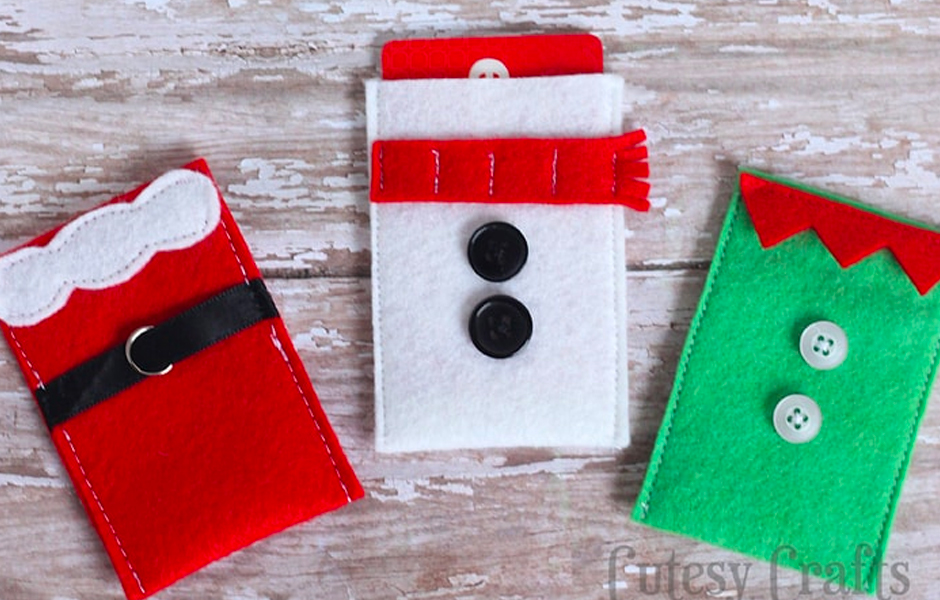
Creative Gift Card Holders
Sometimes, even after searching high and low for the perfect gift, you turn to the old classic – a gift card or cash. While you surely can’t go wrong with such a versatile choice, it’s fun to personalize it a bit more and make it feel more unique. There are countless gift card holder crafts out there, including this one made out of recycled toilet paper rolls (cute and environmentally-friendly!) and these ones made out of felt. If you don’t want to bust out your sewing machine, just grab the hot glue gun and adapt the instructions throughout.
Chalkboard Ornaments
These chalkboard ornaments are super easy, super cute, and serve as a meaningful memento throughout the years. All you need to do is buy some wood slices, black chalkboard paint, and chalkboard markers. If your wood slices don’t come with twine, tie a piece of twine on them to hang them from the tree. Paint each wood slice with chalkboard paint and give the kids a chalkboard marker to draw their masterpiece. Have them sign and date the back and you have yourself a simple Christmas craft idea for gifts for the whole family.
You don’t have to buy the latest gadget or a fancy gift to enjoy the Christmas season. Instead, try a new craft idea for the loved ones on your list. These meaningful gifts show that you care and will remind everyone of the wonderful season you spent together.
Decorating your home with new furniture is exciting and fun, but it can get expensive! With the holidays right around the corner, most of us are looking to score some great deals on gifts for friends and family. You can also score some great sales on furniture, as well, as long as you know where to look.
Here, we’ll share our favorite ways to find furniture on sale, including where to spot this year’s Black Friday sales, how to find cute pieces for less, and how to invest in pieces you love without breaking the bank.

Where to Find Furniture on Sale
There are lots of places that you can score great deals on furniture. Here are some places to look:
Estate Sales
Estate sales are a great place to find some hidden gems, as long as you have the time to look. Sites like EstateSales.net and Garage Sale Finder make it easy to find sales near you. If you don’t see any good sales in your area, don’t be afraid to branch out into the surrounding neighborhoods. Some neighborhoods, such as those with older families looking to downsize, might be more likely to get rid of big-ticket items like furniture.
Second-Hand Websites
Sites like Craigslist and Offer Up have a little bit of everything, but with some patience (and luck) you may find just what you’re looking for at a steep discount. One tip is to search for listings in high-end areas where you’ll be more likely to find some great pieces. Looking for more second-hand websites? Check out this list!
Inventory/Clearance Sales
Sometimes, you can find a furniture store that’s going out of business or needs to clear their inventory so they’re offering major discounts. If you can, wait until the final weeks of a sale to try to get the best deal. They might not have as much of a selection, but if you’re flexible about what you’re looking for, you may be able to find some huge discounts.

Black Friday Furniture Sales
Another way to save money on furniture is to keep your eyes peeled for seasonal promotions. Holidays like Memorial Day and Labor Day mark the change of seasons, which means that furniture stores are likely trying to move inventory to make room for new styles. Plus, there are always big holiday sales like Black Friday.
Furniture stores usually offer some sort of Black Friday sale. This year at participating retailers, we’re offering one of our bestsellers, the Dawson Power Headrest Rocker Recliner, for $200 off regular price. It’s available in four beautiful colors of top grain leather.
You can also take advantage of big-box retailers’ Black Friday sales. Target and Walmart are famous for their doorbuster deals, some of which include furniture. But if you want to avoid the masses, shopping at a local furniture store might be your best (and safest) bet.

How to Save Money on Furniture
In addition to keeping your eye out for Black Friday furniture sales, local deals, or seasonal offers, there are many other ways to save money on furniture. Whether you’re decorating your first home, trying a new interior design style, or just want a fresh look, these tips will help you save money and give new life to some of the stuff you might already have:
– Splurge on a few key pieces and shop around for the best deal on small details like decorations or seasonal accents
– Compare prices online and in-store and ask if the retailer price matches
– Repurpose or refinish things you already have
– See if your furniture store as a “scratch and dent” sale where pieces have minor cosmetic mistakes
– Look for local auctions
– Set up a furniture trade with friends and family
– Have patience and wait for the perfect time to buy your next piece
– Buy the floor sample
– Buy one piece at a time. You don’t need to replace all your furniture at once
Buying furniture is a fun adventure that doesn’t have to cost a lot of money. If you keep your eyes peeled, look for local deals, and keep up with your favorite furniture store’s updates, you can likely score the deal you’ve been looking for.
Buying your first home is an important milestone. You now have a place to call your own and build memories for years to come. Whether you moved your old furniture into the new home or are starting from scratch, now is the perfect time to decorate your space.
These first-time home buyer tips will help you decorate your new home without breaking the bank and make your new space feel like home.
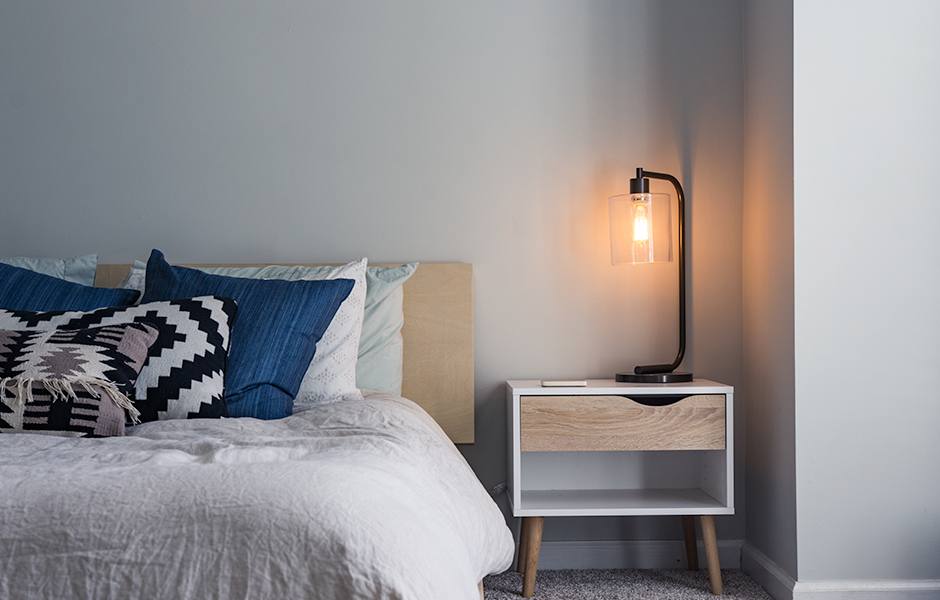
First-Time Home Buyer Tips for Decorating
One of the hardest things about decorating your first home is that you likely saved up for the down payment and now have a mortgage payment to consider. But, that doesn’t mean that you can’t spruce up your new space. These tips will help you stay organized, efficient, and cost-conscious.
Start With Your Needs, Not Your Wants
It may be tempting to start decorating your first home with all kinds of art and decor but focus on the necessities before you start tackling the little details. This might include investing in a new recliner for the living room, a new mattress and bed frame for the master, or some high-quality kitchen accessories. Once you have the necessities settled (and have saved up a little more cash after the big purchases), you can move on to the small things like wall art, creative storage solutions, and other accents to show off your personal interior design style.
Focus on High-Traffic Areas
When you’re deciding what to prioritize after moving in, focus your effort on the areas in the house that get the most use. If you love having dinner parties with friends, make sure to put a nice dining table and beautiful seating options on your list. If you love cuddling up in bed and bingeing the new Netflix series, a comfy mattress is a must. By prioritizing the rooms you know you’ll get the most use out of, you can spread out your furniture shopping, save some money, and take your time.
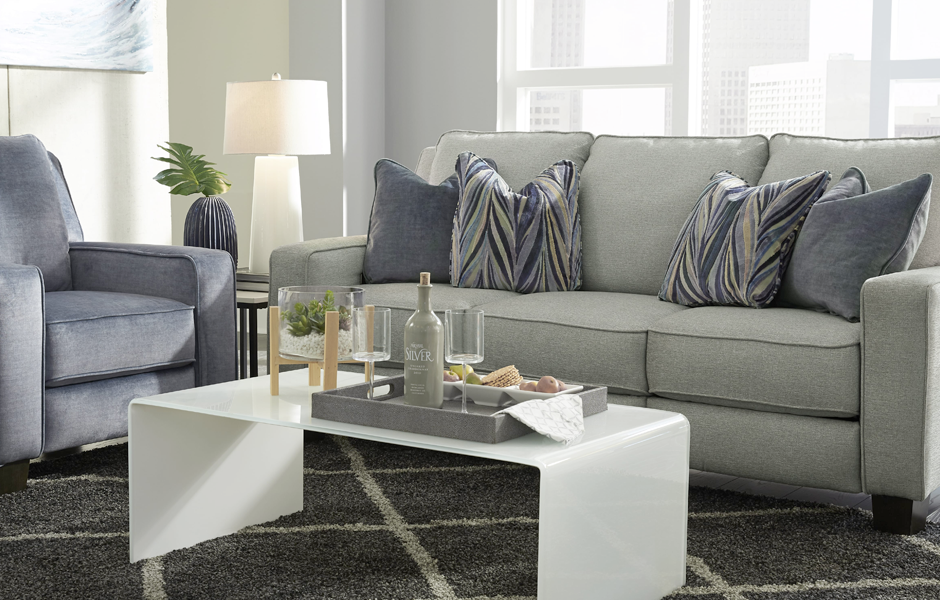
Decorate One Room at a Time
Another decorating tip for first-time homebuyers is to focus on one room at a time. You don’t have to rush to get everything perfect in your new home right after you move in. Take your time, find pieces that you love, and move strategically from room to room. Make a checklist of what you need for each room to feel complete (for now).
Refurbish, Repurpose, and Recycle
Buying new furniture for your new space is exciting, but there are lots of other ways to spruce up your new home on a budget. Refurbishing old pieces makes them look brand new and recycling things from family and friends is a great way to give a loved piece new life. This video shares some fun ways to upcycle old furniture and give a space new life.
Invest in a Few High-Quality Pieces
After making one of the most expensive purchases of your life, it can be hard to decide when to save and when to splurge on home decor. There are countless places where you can find affordable home decor, but sometimes it’s worth it to spend a little more and know that what you’re buying will last. When decorating your first home, less is more so focus on investing in pieces you love, rather than just trying to fill the house. This could include a beautiful new sofa, a piece of artwork from your favorite artist, a unique lighting fixture, a high-quality rug, or anything that means a lot to you. You can then save for things like trendy art prints, cool mirrors, curtains, and other finishings.
Buying your first home is exciting but decorating it can feel overwhelming, especially since you just made such a major purchase. But by focusing on the areas in your home where you spend the most time, upcycling some of your existing pieces with easy DIY decor projects, and investing in a few key items, you can make your new house feel like home in no time.
You spend 40 hours a week (or more) at work, so it’s important to make your workspace and environment your sanctuary. From decorating your desk to finding ways to be more active throughout the day, let’s share some of our favorite workplace wellness ideas!

Make Your Desk Feel Like Home
The first, and most impactful, workplace wellness idea is decorating your desk. Studies show that employees with plants at their desk are 15% more productive, different colors can enhance your mood (blue and red have been shown to improve brain performance), and surrounding yourself with inspiring items can help motivate you throughout the day. There are many ways to decorate your desk and it will depend on your personal preferences, but here are some tips:
– Eliminate clutter on your desk. If you don’t use it every day, put it away
– Include personal items, like pictures of loved ones
– Include work-related decorations, like motivational quotes or a fun calendar
– Try to get rid of any long cords you have under your desk. If you can’t get rid of them, use a solution to tuck them out of your way.
– Listen to white noise to increase productivity
– Make sure you have something to keep you warm if your office is chilly, such as a cozy blanket, a space heater, or fingerless gloves
– Invest in alternative seating options, such as a yoga ball, to help improve your posture. According to the Mayo Clinic, poor posture can cause headaches, back and neck pain, breathing problems, pinched shoulders, and jaw pain.
– Don’t be afraid to leave your desk and work in other areas of the office, such as a lounge or even the break room (if you don’t need to be deeply focused)
– Make sure to have a reusable water bottle handy to stay hydrated. Dehydration can make you feel lethargic throughout the day.

Prioritize Workplace Wellness
Being at work doesn’t mean you can’t prioritize your wellness. From being more active throughout the day to taking care of your mental health, these tips will help you feel better and, hence, work better:
– Incorporate natural elements, like plants or sunlight if possible. If you don’t work by a window, take short walks outside to get some good old Vitamin D. Workers in windowless environments reported significantly lower well-being compared to those in a sunny office, according to a 2014 study from Northwestern University and the University of Illinois at Urbana-Champaign.
– Keep healthy snacks at your desk (that way, you’re not tempted by the vending machine!)
– Invest in a standing desk or take a short walk around the office every hour or so. Research shows that walking around for five minutes every hour boosts mood while reducing fatigue and food cravings.
– If you’re stressed, try to incorporate short meditation or mindfulness practices into your day. Smartphone apps like Calm and Headspace make it easy. Even five minutes to yourself can change your day and increase your productivity.
– Take breaks to stretch or give yourself a quick head and neck massage.
– It may seem counterintuitive, but multitasking actually means you get less done. Try to focus on a few priority projects rather than a million little things throughout the day.
– Turn off distractions, including email. The most productive entrepreneurs (including Tim Ferriss in his book The 4-Hour Workweek) suggest checking email at certain times of the day, rather than having notifications always on. That way, you can address everything in bulk and focus on your priority projects (refer to the above tip).
– Have a screen-free lunch break
The happiest and most productive employees prioritize their work, but they also prioritize their physical and mental wellness.

Workplace Wellness Ideas for Employers
The above ideas are great for employees to prioritize their workplace wellness, but creating a happy, healthy workplace depends on the employer, too. Improving your workplace wellness doesn’t have to cost a lot and will result in more productive employees that actually enjoy coming to work. Here are some ideas:
– Create alternative workspaces with comfortable seating, healthy snacks, and a view outside. You could even add a massage chair to really help your employees relax. There are countless physical and therapeutic benefits of massage therapy and taking a quick rest can help rejuvenate your employees throughout the day.
– Set up standing desks. If you don’t have the budget to provide every employee with a standing desk, create standing work stations that they can work at. As mentioned above, standing and moving more throughout the day is one way to stay healthy in the workplace.
– Plan team outings to help your employees get to know each other outside of the office. Things like team BBQs, scavenger hunts, or field days are a great way to get people outside and moving and will help your employees bond.
– Create fitness, yoga, or meditation sessions with the team
– If possible, offer flexible work hours. Some employees might be more productive at home or might benefit from a flex schedule.
– Think of various dietary restrictions/preferences when shopping for workplace meals and snacks and include healthy options.
Things like standing desks, team events, or desk decorations might seem insignificant in the grand scheme of a business, but these little workplace wellness ideas can help you feel more motivated, productive, and happier to come to work. Whether you’re an employee or an employer, investing in the space where you spend the majority of the week just makes sense. As you invest in making your workspace comfortable for you and your employees, learn more about the importance of lumbar support and why you need it during stationary activity.
Modern, contemporary, mid-century, boho chic, country cozy – there are countless design styles to choose from! Do you know yours? This quiz will help you understand your personal interior design style.
Minimalism doesn’t mean limiting yourself, it means loving each piece that you own. Do more with less and embrace the KonMari Method to declutter your home and find joy in simplicity. From your favorite chair to your go-to outfits, learn more about how to declutter, love the pieces you have, and invest in quality over quantity to create the perfect minimalistic home that fits your needs.
What is the KonMari Method?
The KonMari Method is a tidying and organizing method developed by best-selling author Marie Kondo. This method is focused on creating a tidy environment by removing any items that no longer “spark joy” and instead create unnecessary clutter in your home. According to her site:
“The KonMari Method™ encourages tidying by category – not by location – beginning with clothes, then moving on to books, papers, komono (miscellaneous items), and, finally, sentimental items. Keep only those things that speak to the heart, and discard items that no longer spark joy. Thank them for their service – then let them go.”
There are plenty of other decluttering methods that others use, but the KonMari Method is a more rigid approach that many have found success in for organizing their lives and leading to a more minimalist lifestyle.
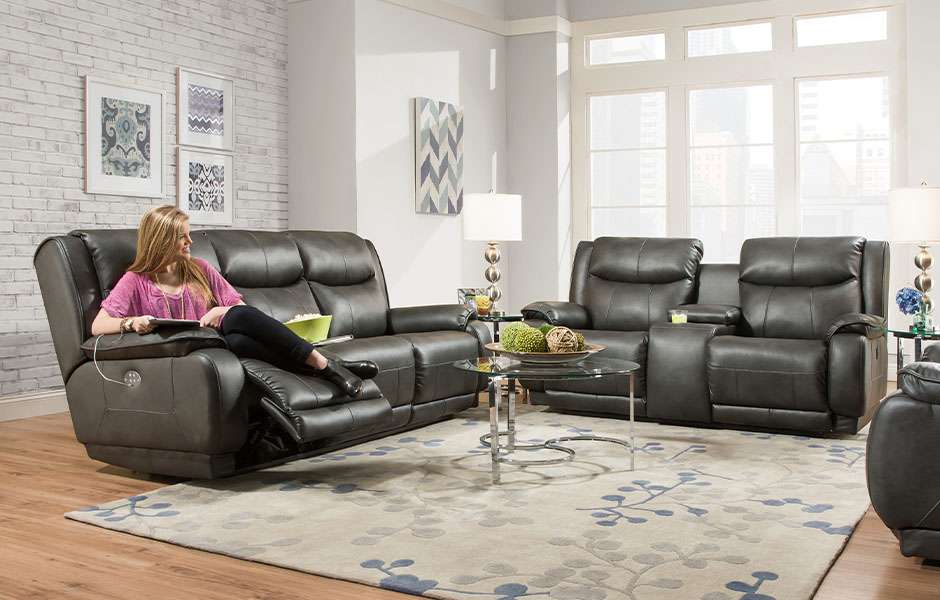
Minimalist Interior Design Tips
While the KonMari Method focuses on decluttering by category and not space, knowing how to tackle different parts in your home can be a big help in your tidying efforts. Compartmentalizing each room and practicing the KonMari Method in each can be a great start for your lifestyle shift into tidiness. Follow these minimalist interior design tips to help clear up space in your home and live a clutter-free life!
Tip 1: Minimalist Living Room Ideas
Your living room should be a place of relaxation and gathering, so focusing on having comfortable spaces and a bright, open space is ideal. If clutter resides in your main entertaining room, it could be a sign of blocking off your true self to guests. To tidy up your living room, focus on keeping pieces that maintain a light and welcoming vibe while showing off a few select pieces that spark joy and show off your personality. Choose your favorite piece of art or some conversational coffee table books to accent simple-but-beautiful pieces of furniture that maximize both space and comfort.
Tip 2: Minimalist Kitchen Ideas
Almost every kitchen has this one dreaded item: the junk drawer. Kitchens are a main hub for family life, from cooking to doing homework to feeding your pets, so it’s easy to accumulate random “junk”. When decluttering the kitchen, focus on prioritizing what you do and use most. For example, if you make more coffee than tea, store the tea kettle away until it’s needed. Take time to organize things like Tupperware and lids, as simple reorganization can free up 50% more space in your kitchen and make things easier to find. And yes, that means tackling your junk drawer! You’ll thank us later.
Tip 3: Minimalist Bedroom Ideas
Having a minimalist bedroom doesn’t mean minimizing your own style or comfort, it simply means only having things in the room that promote rest and relaxation. Falling asleep in a messy room can lead to distractions that keep you from getting proper rest. Keep your personality with pops of accent colors, fun bedding, plants, art, mirrors, and rugs. As part of your bedroom, having a tidy closet is necessary as well. Remove pieces that no longer spark joy and use proper folding methods to save time finding your favorite outfits and have clothes you’ll actually wear.
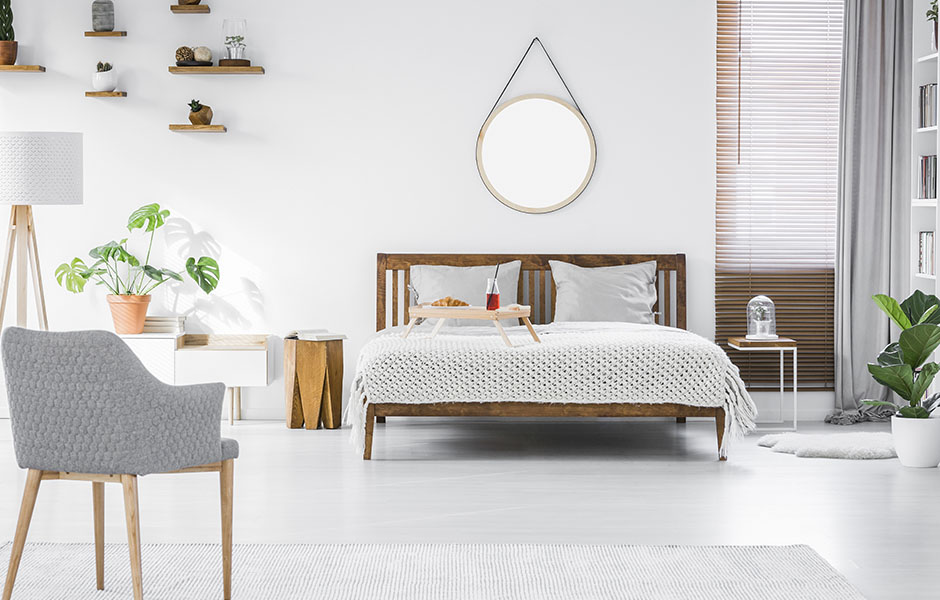
Benefits of Decluttering Your Home
Having a tidy home doesn’t just come with the perks of finding things easily and having a clean house to show off. There are more lasting benefits of decluttering your home that make the time and effort put toward it worthwhile, such as:
- Better Sleep: Some studies show that hoarders, or people with too much stuff, are more likely to suffer from sleep issues and experience sleep disturbances. While hoarding is more extreme than a messy room, it’s easy to see that a tidy room can cut down on distractions or disturbances while trying to sleep and lead to a better night’s rest.
- Clearer Focus: This decluttering benefit all depends on the person. For most, clutter equals stress. If you are someone who is more stressed by a messy environment than inspired by it, tidying up your environment can allow your mind to focus on a project or task at hand instead of focusing on the stress of the clutter around you.
- Improved Air Quality: Clutter means more surfaces in your home for dust to settle on and allergens to accumulate between. By tidying up your space, you are forced to tackle the dust head-on and reduce potential spots for future accumulation. With a tidy home, you’ll spark joy with how little your allergies act up.
- Reduced Anxiety: Running late because you can’t find your keys? Stressed because your measuring cups are buried deep within your kitchen? Can’t find an outfit to wear in your overcrowded closet? When you declutter, you remove the anxiety of information overload and uncertainty of knowing where to find things.
Whether you use the KonMari Method to go through the ultimate living room decluttering list or simply spend 15 minutes every day to tidy up a new space, taking the time to tidy up your house has many benefits. Try to incorporate the tips above to start leading a healthier and happier life at home!
The end of summer is an exciting and hectic time of the year if you are a parent. Back to school time can be difficult for moms and dads – it means schedule shifts, shopping trips, new house rules, and just overall running around to get everything in order so their first day back is as great as possible. Read on to learn what to do to get ready for back-to-school season and how preparation is any parent’s best friend during this busy time!
Back-to-School Tips for Parents
1. Define Boundaries
Whether your children are elementary or high school age, setting boundaries for the new school year will lead to a harmonious home. Sure, rules don’t sound like a lot of fun for your kids, but they help set expectations and decrease the chances of stressful situations.
Set boundaries on things such as screen time, curfews, homework rules, having friends over, house duties, or anything else that requires communication in your home. Be firm and precise in your boundaries, but try not to be too strict to keep a positive environment.
2. Enjoy the End of Summer
One of the biggest back-to-school tips is to enjoy the time before school starts. While many parents are probably ready to get back to a regular schedule again, it’s important to remember to take advantage of the free time and summer activities available before everyone is busy again.
Plan a quick weekend trip, visit museums and exhibits, enjoy time outside with a picnic or beach day, try to get in some last minute summertime activities as a family before free time is filled with school obligations.
3. Get Back on Schedule
The summer is notorious for making us lose track of what day of the week it is. With no schedule and long days of various activities, going back to school after summer break is a big schedule change. In the couple of weeks leading up to back-to-school season, try to get back on some sort of routine.
Set alarm clocks earlier and earlier on Mondays through Fridays, start having family dinners around the same time every night, and try to establish an earlier bedtime to make it easier to transition into the school year.
4. Make Dedicated Spaces
Similar to setting boundaries for actions, set up dedicated spaces in your home for different activities. As a parent, you’ve probably realized that your children can take up a lot of space in the house. To keep order and avoid conflict arising from different activities in the same space, decide where you want to do what and when.
For example, the living room is free space until 8 pm, which is when mom and dad get to watch their shows. Or, the kitchen table is a study space until 6 pm when dinner is served. If you need a true space of your own, consider a she shed or a man cave just for you!
5. Set Up a Smart Home
Making your house into a smart home is one of the easiest ways to simplify your life, and therefore reduce stress during back-to-school season. Smart home devices include voice assistants like Siri and Alexa, smart appliances like refrigerators and coffee pots, and even smart furniture!
Using smart devices can help you keep track of groceries, set morning alarms, make back-to-school shopping lists, brew a cup of coffee, relax and unwind, and even help your children with their homework. Connecting your home helps keep the whole family connected.

6. Take Time for Yourself
Being a parent is often a thankless job, especially when it comes to kids going back to school. From all the preparation you do before with schedule planning and back-to-school shopping to everything you do once the school year is in full swing, you deserve some rest and relaxation.
Take time for yourself whenever you can, whether it’s with a simple massage at home in your favorite SoCozi recliner or with a night out when your teens are out of the house with their own plans. It’s easy to get stuck in parent-only mode, but never forget to treat yourself!
7. Write a Shopping List
Last, but certainly not least, is the most important back-to-school tip! You may think you’ll be set by just grabbing a few notebooks, a fresh pack of pencils and pens, and some binders, but there is a lot more to back-to-school shopping than you’d expect.
Sit down with your children and see if they have received any supplies lists from teachers, then make a shopping list for back-to-school clothing or anything needed for the house such as desk supplies or groceries for lunches and after-school snacks. Being under-prepared on the first day of school is never a great first impression.
One final tip? Make sure to have family time every day if possible. Whether it’s cozying up on the sofa to watch a show or having breakfast every morning, family time helps ground everyone from the hectic days of work and school.
Surviving Back-to-School Season
Preparing for your kids going back to school can be a lot of work, but it doesn’t have to be stressful! By following these tips for back-to-school season, you and your children will have an easy transition back into the school year. If you and your kids are looking for a comfy spot to practice reading, check out our selection of recliners that’ll make reading time one of the most relaxing activities of the day!
Whether you just bought a new home or want to refresh a current look, it can be tough to find a design you love at a price you can afford. But how do you know when it’s worth it to splurge and when you should save by finding similar items for less?
Here, we’ll share some of our simple furniture swaps that can amplify any room. Instead of turning to the traditional pieces, take our advice and splurge on pieces worthwhile and save on some designs that you can find elsewhere.
Buy a Custom Recliner Instead of a Mass-Market Chair
One piece of furniture that’s worth splurging on is a custom ordered recliner. Choose your style, upholstery, extra options, and enjoy the recliner made just for you! A beautiful chair can really bring a room together and isn’t something you want to skimp on, especially since you might spend a good amount of your relaxation time kicking back in your recliner. Plus, if you invest in a high-quality recliner now, it can last for years.
Buy Designer Look-Alikes Instead of the Real Thing
Sure, designers like West Elm and Pottery Barn have beautiful things, but depending on what you buy, you can find these pieces elsewhere for a lot less. The website Decor Look Alikes shows some of the most common items you can get that look similar to their designer counterparts. Decorative details can also be found at thrift stores, farmers markets, garage sales, and other affordable spots.
Buy an Overlay Instead of Expensive Dressers
Dressers and side tables can get expensive and even though they’re useful, they’re not a piece you have to spend big money on. But, many consumers get frustrated that the cookie-cutter furniture they can find on a budget lacks the personality they want to include. Enter, overlays. Overlays are custom-made texture piece that you can add to the face of dressers, nightstands, and even walls in your home. Check out this gallery to get some ideas that you can do with a simple overlay. Overlays range in pricing, depending on your style and size requirements.
Another way to spruce up a set of drawers instead of buying new ones is to add new hardware. You can easily replace the knobs on drawers, the legs on a sofa, or other accents.
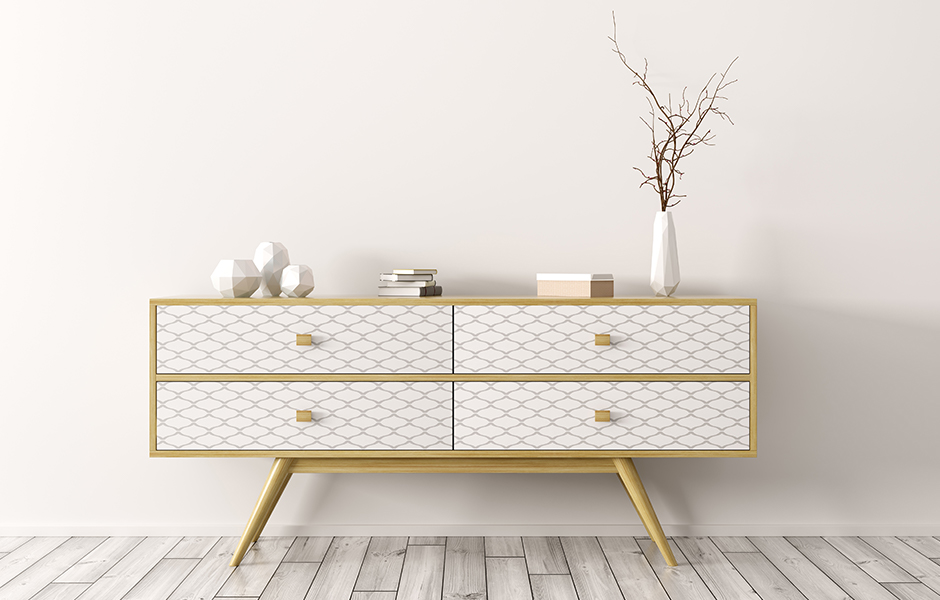
Buy Wallpaper or Contact Paper Instead of Painting
That being said, if you don’t want to paint the whole room you can use contact paper or wallpaper to change up the look without having to spend a lot of money. Both come in a wide variety of patterns and colors, including marble, granite, wood, and fun designs.
Buy High-Quality Paint Instead of a Cheap Alternative
One of the best ways to spruce up a room is to add a pop of color, either to the walls or to a piece of furniture. But, if you’re embarking on this mission to spice up your interior design, make sure you splurge for a high-quality paint, rather than taking a shortcut with cheaper paint. The nicer paints usually come with a built-in primer, which will save you time and effort. Plus, their coats will last longer and look better on your finished piece.
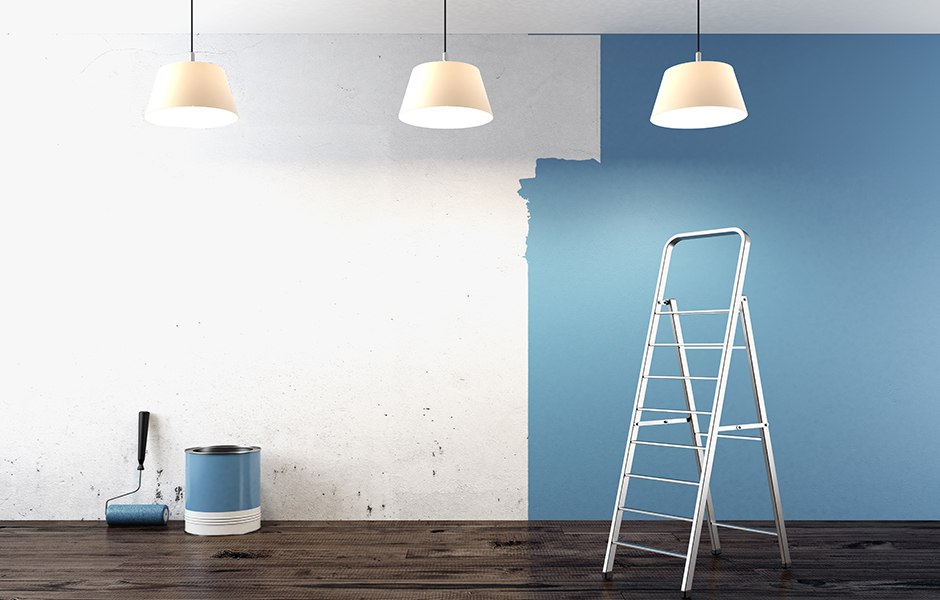
Your interior design doesn’t have to cost an arm and a leg, but it can still look great. Splurge on some pieces, like a reclining chair or a paint color you really love, and find easy swaps for things you want to save on. To cut down costs even more, discover how to find furniture on sale throughout the year.
